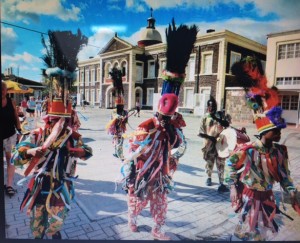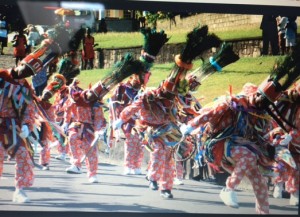My first blog featured an avatar of the masquerades, who symbolize one of the folklore traditions of my country, St.Kitts and Nevis. Historical records in the National Museum indicate that this group of dancers first performed over 300 years ago while they were still enslaved.Today, they continue to attract large crowds of residents and tourists to their performances which are very much like street theater, as the dances are primarily done in open spaces on streets and courtyards.
The masqueraders wear tall head gear made of colorful peacock feathers, sometimes with masks attached. Additionally, they dress in brightly colored pants and shirts with fringed aprons that reach just above the knees. The entire costume is decorated with bells, mirrors and ribbons of many different colors. They also carry tomahawks which are used in one of their dances. Dance experts have identified aspects of the European and African genres in some of their dances. For example, The performances would usually start with the Quadrille, a dance dating back to 17th century France. Next they would do the Fire Dance, skilfully dancing on one foot and moving to the center of a circle that they have made. Following this, they would perform the Fertility Dance, simulating the Mating Dance from Africa. Other performances could include the European Waltz, the African Wild Moos, the Rhumba, the Jig and the Boilla.
Traditionally, the dancers were all males of different age groups. However, by the early 20th century, performances began to decline as some dancers died, while others were too ill or infirm to participate. Women became increasingly interested and joined the troupes in their performances. If the decline was allowed to continue, the cultural art form would have ‘become extinct’. Therefore, the Ministry of Education embarked on a project to sustain the Masquerades. Performers who were still active traveled around the country, teaching the dances to the primary school students, showing them samples of their costumes, and explaining the historical significance of the masquerades who represent a cultural blend of our Amerindian, African and European heritage. This proved rewarding as many students became excited and got involved.
While I applaud the Ministry of Education for taking this bold step, I am concerned that the teaching methods used will not continue to engage the youth who now live in a digital world and frequently use devices such as i phones, i pads, Amazon Kindle readers and computers. A critical opportunity will be missed if teachers do not also take advantage of the range of possibilities offered by this cultural art form to teach Composition, History and Culture across disciplines, using digital technology. Cynthia L. Selfe argues ” in an increasingly technological world, students need to be experienced and skilled not only in reading (consuming) texts employing multiple modalities, but also in composing in multiple modalities, if they hope to communicate successfully within the digital communication networks that characterize workplaces, schools, civic life, and span traditional cultural, national, and geopolitical borders.”
I believe that teaching the art of masquerading should not be limited to demonstrations and dance practice sessions. But, in addition to these, students can engage in their own research activities on the internet websites, use social media such as Facebook or Twitter as a forum to exchange written information and ideas. They can also be encouraged to create games and avatars symbolizing the masquerades, and view video performances by the group. These added activities, while encouraging enthusiasm, can help create better thinkers, writers and readers. Selfe quite rightly states: “Aural and video compositions sometimes reveal and articulate meanings students struggle to articulate with words; audio and visual compositions carry different kinds of meanings that words are not good at capturing.” This is yet another exciting adventure students can engage in as they communicate through sound and movement and develop forceful appeals through pathos, logos and ethos.
St.Kittstourism.Kn
St.Kittsheritage.com
Selfe Cynthia L, Multimodal Composition, Resources for Teachers



